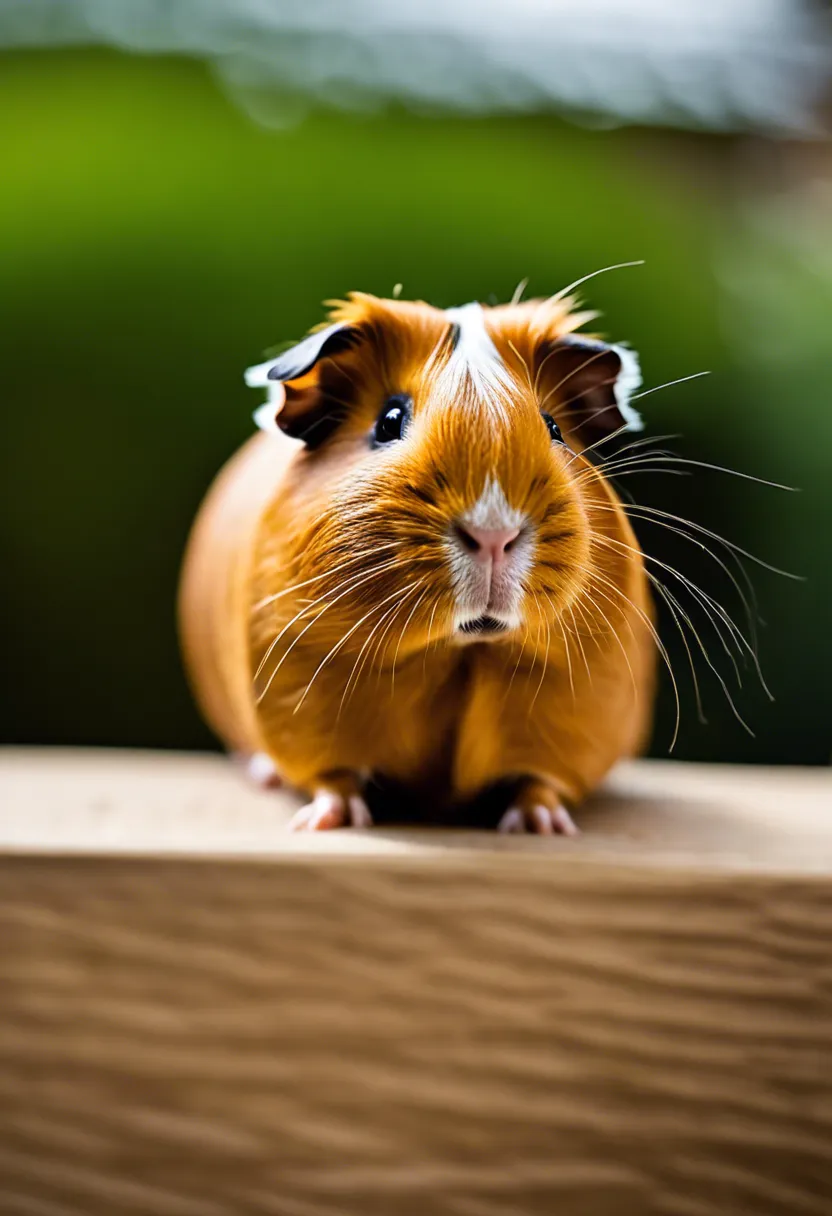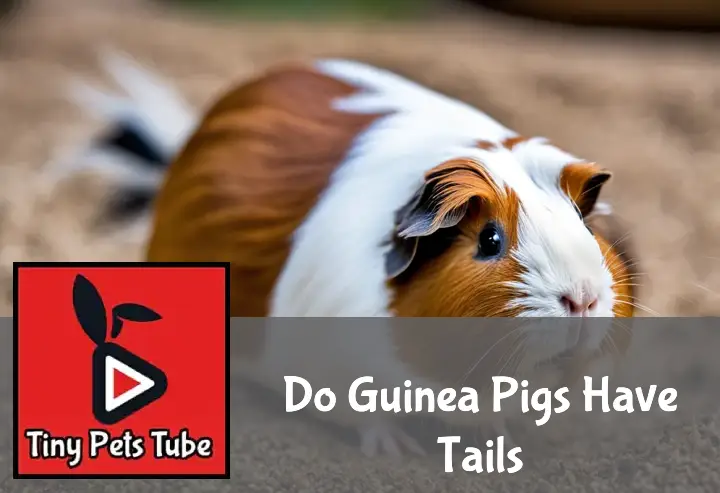Ever found yourself pondering over the question, Do Guinea Pigs Have Tails? Well, you’re not alone! It’s one of those little mysteries that has stumped many a guinea pig enthusiast.
In this blog post, we’ll dive into the fascinating world of guinea pig anatomy and unravel this tail-tale mystery. Keep reading about ‘Do Guinea Pigs Have Tails? A Closer Look At Guinea Pig Anatomy’.
Key Takeaways
- Guinea pigs do not have external tails like many other animals.
- They have a small bone at the base of their spine, which is often mistaken for a tail.
- This tiny bone is called the ‘coccyx’ or ‘tailbone’.
- The coccyx is not visible as it’s covered by fur and skin.
- Unlike other rodents, guinea pigs’ lack of a visible tail is due to their evolutionary history.

Do Guinea Pigs Have Tails?
Let’s dive into the quirky world of guinea pigs and answer the burning question: Do Guinea Pigs Have Tails? It’s a fascinating topic that sheds light on their unique anatomy and care needs.
Understanding the Anatomy of a Guinea Pig Tail
So, you’re curious about whether your fluffy friend sports a tail. Well, technically, guinea pigs do have tails, but don’t expect to see anything wagging! Their guinea pig tail is more of a tiny nub hidden under their fur. This little stump doesn’t serve much purpose in terms of balance or communication like in other animals. Instead, it’s just a vestigial part that reminds us of their evolutionary journey. When looking at the anatomical features of guinea pigs, it’s clear they’re built more for cuddling than showcasing any significant tail action. This insight into pet anatomy insights not only satisfies our curiosity but also helps us appreciate the uniqueness of our pet companions.
Comparing Guinea Pig Tails to Other Rodents
When we put guinea pig tails up against those of other rodents, things get interesting. For starters, think about squirrels with their bushy tails or rats with their long, expressive ones. These tails often play critical roles in balance, communication, and even thermoregulation. However, our guinea pig pals march to the beat of their own drum with their almost invisible tails. This difference highlights an intriguing aspect of evolutionary adaptations in rodents. Each species has developed features that best suit its environment and lifestyle – from climbing trees to burrowing underground. Through this lens of comparative anatomy studies, we gain a deeper appreciation for the diversity among our small pet friends and how each has adapted uniquely over time.
What is the Purpose of a Guinea Pig’s Tail?
Ever wondered Do Guinea Pigs Have Tails and if they do, what on earth are they for? Let’s dive into the nitty-gritty of guinea pig tails and their secret lives.
The Evolutionary Role of the Tail in Rodents
Rodent tails have a fascinating evolutionary journey. Initially, these appendages served as balancing tools, helping our furry friends navigate through their environment with ease. As time ticked by, tails evolved to serve even more purposes. They became instrumental in communication among rodents, signaling danger or readiness to mate. The adaptive functions of tails didn’t stop there; they also played a crucial role in thermoregulation, allowing rodents to adapt to varying climates by dissipating heat or retaining warmth. This versatility highlights the evolutionary significance of tails, showcasing how essential they’ve been for survival and reproduction across different rodent species.
How Guinea Pigs Use Their Tails
Now, onto our cuddly guinea pigs. You might be scratching your head thinking, “I’ve never seen a guinea pig tail!” And you’re not entirely wrong. Guinea pigs do have tails, but they’re so tiny that they’re often overlooked. Unlike their rodent cousins who flaunt their long, expressive tails, guinea pigs sport a modest stub mostly hidden under their fluffy behinds. But don’t let its size fool you; this little tail still has its uses. In terms of guinea pig tail usage, it’s less about balance or communication and more about comfort. When settling down for a nap or squeezing into cozy corners, that tiny tail ensures nothing gets caught or pinched awkwardly. It might not seem like much compared to the dramatic swishing of a squirrel’s tail or the intricate signaling system of rats’ tails, but it’s just another quirk that makes guinea pigs uniquely adorable.

How to Care for Your Guinea Pig’s Tail

Taking care of your guinea pig’s tail is crucial, even though it might seem like a tiny detail in their overall health and hygiene routine.
Regular Check-ups and Potential Health Issues
When it comes to guinea pig tail care, regular vet visits are your best bet to catch any sneaky issues early on. These little critters can sometimes get into mischief, leading to tail infections or injuries that aren’t always obvious at first glance. It’s all about keeping an eye out for signs of trouble, like your guinea pig fussing over their tail more than usual or any visible sores.
Preventive health measures play a huge role here. By scheduling veterinary care for guinea pigs routinely, you’re not just getting ahead of potential tail troubles but also ensuring their overall wellbeing is checked. Common guinea pig tail injuries often stem from accidents in their enclosure or rough handling, so knowing what to look out for can save you and your furry friend from unnecessary stress.
Grooming and Cleaning Tips for Your Guinea Pig’s Tail
Now, grooming your guinea pig might not be the first thing on your mind when you wake up, but it’s pretty important for their hygiene. Especially when we talk about cleaning a guinea pig’s tail, gentle handling is key. You don’t want to spook them or cause any harm while trying to keep them clean.
For those wondering about the tools of the trade, sticking with recommended grooming tools for small pets is the way to go. Soft brushes or even a damp cloth can work wonders without overwhelming your little buddy. And remember, less is more; you don’t need to bathe them frequently—just spot clean as needed and keep their living area tidy.
By incorporating these simple yet effective tail grooming tips into your routine, you’ll ensure your guinea pig stays happy, healthy, and clean without much fuss. Plus, it’s another way to bond with your pet through gentle care and attention.
Interesting Facts About Guinea Pig Anatomy
Guinea pig anatomy is chock-full of surprises that not only make them unique but also incredibly adorable. From their unique body structure to the way they communicate, every aspect of their anatomy plays a crucial role in their behavior and how we care for them. Let’s debunk some myths and dive into the fascinating world of guinea pig anatomy.
Unique Features in a Guinea Pig’s Body Structure
When you look at a guinea pig, it’s easy to notice they’re not just your average rodent. Their skeletal structure is designed to support a robust body, lacking the tail that many other rodents sport. This makes you wonder, Do Guinea Pigs Have Tails? Well, they actually have a very tiny one, but it’s so small that it’s almost invisible!
Their fur types can range from short and smooth to long and flowing, or even curly, making each guinea pig uniquely beautiful. This variety in fur types isn’t just for looks; it also has implications for how we care for them, requiring different grooming techniques.
Another standout feature is their sensory capabilities. Guinea pigs have an excellent sense of hearing and smell which helps them navigate their environment and communicate with each other. They might not see colors as vividly as humans do, but what they lack in color vision, they make up for with these heightened senses.
Common Misconceptions About Guinea Pigs
One common myth about guinea pigs is that they can survive on dry food alone. In reality, their dietary needs are much more complex. They require fresh hay daily for digestive health and vitamin C-rich foods since, like humans, they can’t produce this essential vitamin on their own.
Another misconception is that guinea pigs are loners when the opposite is true. They thrive in social environments with other guinea pigs where they can communicate and interact. Understanding these aspects of guinea pig care facts helps us provide better environments for our furry friends.
Lastly, there’s often pet health misinformation circulating about guinea pigs being easy starter pets that don’t need much attention. However, their unique anatomical features and social nature mean they require thoughtful care and regular interaction to stay healthy and happy.

To Wrap Up
Well, there you have it! Just like a magician’s hat without a rabbit, our lovely guinea pigs are tail-less wonders. But don’t let this fool you, their cute little rumps are part of what makes them unique. If you’re still curious about the question Do Guinea Pigs Have Tails, feel free to dig deeper!
Remember to appreciate your guinea pig for all its quirks and features. After all, who needs a tail when they’ve got personality in spades? Keep exploring and keep loving your furry friends!


